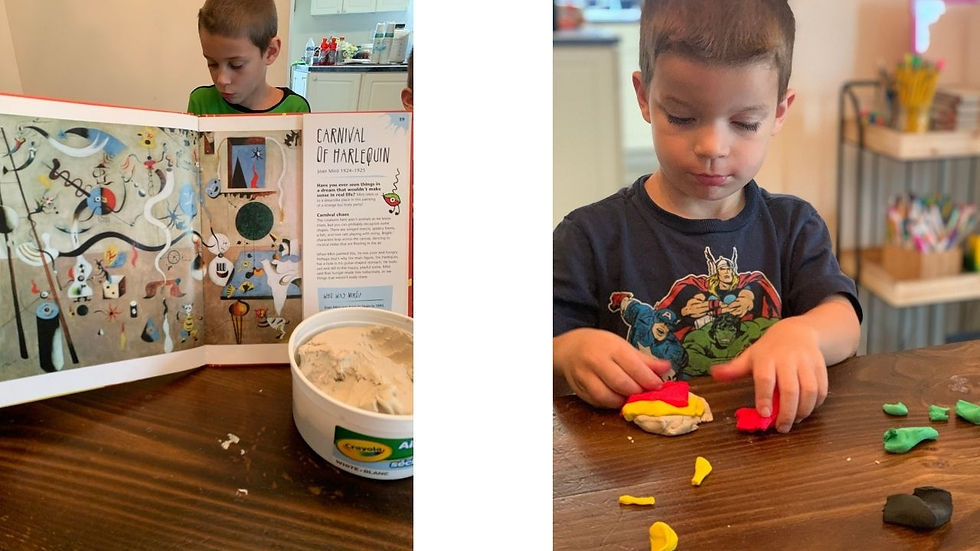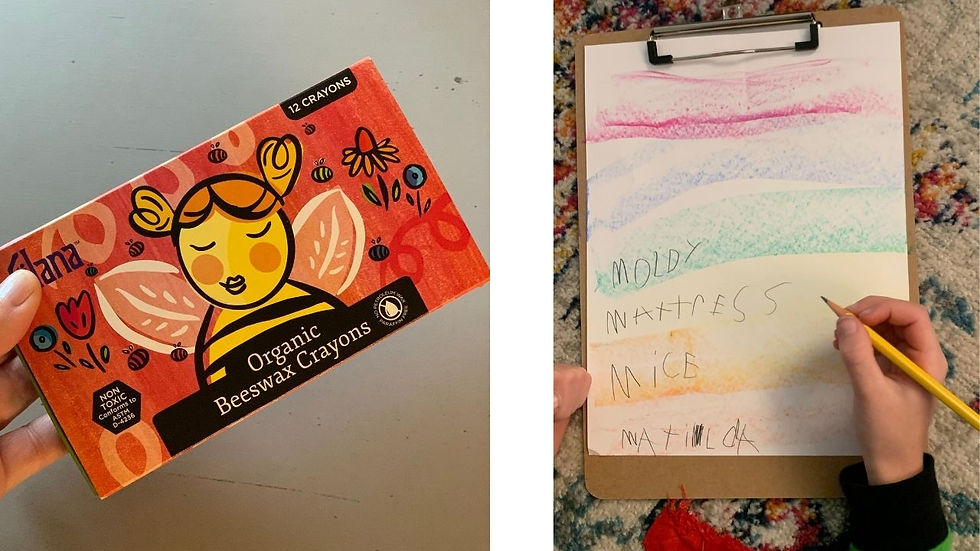Homeschool Art Curriculum
- Erica Lucas

- Aug 7, 2021
- 5 min read
Updated: Mar 1, 2023
How to teach Art in Homeschool
We use the Get Into Art series of books as "spines" as our homeschool art curriculum. I create a plan from each book. We use the globe to find where the artist was born, a timeline to track the years of each art piece, the internet to find images of the artist and the galleries.
What is a Homeschool Spine?
A "spine" is a book that is referenced for most curriculums.

Mixing Art with Other Subjects
Art is one of those subjects that gives you so much freedom to teach. Last year, we focused deeply on styles (line art, etc.), art tools, composition, color usage and types (warm vs cool). This year, we are studying specific art periods and spinning it to include geography and history, as those are new subjects for us this year.
My children are 4, 6, and 7. Geography and history have been child-led in our home until this year, and I've planned a deeper and specific focus on both for the 2021 - 2022 homeschool year. My children fall into pre-K, first grade, and second grade.
We are using our homeschool art curriculum to add in geography and history, and we also have geography "scheduled" on Fridays. We attend a homeschool co-op on Thursdays and the collected families group by level/grade to teach history from Blossom and Root's River of Voices.
Homeschool Co-Op
Our co-op meets for four hours a week with 17 families. We have a large group and we cover history and science for grades 1 and 2, after an hour of meeting as a group focused on character building, emotion learning, and more. The last hour is for lunch and play.
ADVERTISEMENT
Homeschool Art Curriculum
I plan 8-10 weeks of lessons (we teach from this book once a week) from each of these four books, and that covers the entire homeschool year. You can find each of these homeschool art curriculum books here:

Our focus this year is to study different styles of art by looking at examples of paintings, sculpture, and more. We will also visit a few museums and see art in person. My kids love art time and ask many questions.
ADVERTISEMENT
How to Teach Homeschool Art
One of the beautiful parts of homeschool is that you can teach your children to their levels, and teach what you think is appropriate (within state regulations, of course). We have to teach Art in Maryland, USA, and using these books as spines allows us to meet the requirement.
In each lesson, we:
look up an image of the artist
find his/her birthplace on the globe
timeline the year the piece was created and figure out the years between then and now
ask them what they see and feel when they look at the piece
read aloud the text next to the piece.
look up an image of the gallery housing the art piece and discuss if a field trip is possible
use the suggestions to create art at home inspired by that piece
The Get into Art series features a piece from an artist that goes with the theme of the book (animals, places, stories, or people). Each page gives a short history of the piece, the artist, and offers a suggestion to extend the lesson by creating something.
With each art lesson, we also incorporate history and geography. We use our globe to find where the artist was born, and timeline the year of the piece.

In this particular lesson, we studied Carnival of Harequin painting by Joan Miro. We talked about expressing emotions as the artist depicted himself as sad amidst happy things. We talked about surrealism and made surrealist monsters from clay (the book suggested that).

I read aloud while the kids played with clay. I talk more about supplies below.

The kids also drew their own surrealist animal using crayons (another book suggestion).

ADVERTISEMENT
Homeschool Art Supplies
Each book shares a master supply list in the back of the book. When I plan from each book, I make a note of the supplies needed for that week (sometimes we skip around and I can just glance at my notes).

Over time, we've amassed plenty of leftover supplies for homeschool art but I always need to pick up some things along the way. It helps (me) to stick to one book at a time, and collect all the needed supplies for that book in one spot.
We have a school cart and an art cart in our dining room. We homeschool on our couch, outside, on the floor, and at our table. We do not have a dedicated school room, but as minimalists most of our everyday supplies fit onto these two carts.

ADVERTISEMENT
Well, most of our everyday homeschool supplies. I grant an exception to that statement for books and our morning basket. Books live all over our house. Our morning basket is kept next to our couch in our living room.

ADVERTISEMENT
Homeschool Art in our Morning Basket
We read a few books aloud each morning as part of our morning basket. We take our time and look at the pictures the illustrator drew for the books. It's just another opportunity to appreciate art at home.

My youngest son (4) likes to point out what he sees and help turn the pages. My daughter (6) especially loves art appreciation and she spends more time coloring and painting than any other activities. My oldest son (7) likes the tactile art projects - he's very sensory driven. He likes clay, playdoh, hand painting, etc. Anything that makes a mess. :)

My daughter will find inspiration from books (she loved this page) and ask me to stay on the page. I use a cookbook stand to hold books when she asks. She will stare it for several minutes then go paint. We may have an artist in the making!
This stand either lives near our homeschool morning basket so I can strew a book onto it and see if any kids notice it. Other times it lives near the art project my daughter is working on.
A short love letter to new homeschool moms...
I didn't do it like this in the beginning four years ago. I didn't have patience or the materials. We built to this over time, and I have learned along the way. I have learned to leave space in our day for my daughter's love of art and her need to proceed slowly.
My boys like to go fast then get to playing. She likes to take her time. In the picture above, my oldest (7) was done 10 words with this white crayon - color marker spelling sheet in about 10 minutes. She's on word #3 and she's been doing it for 20 minutes. After about 90 minutes, she had completed 12 words (I asked for 5 "M" words from the book) because she enjoyed the coloring trick.
We vary spelling practice - sometimes we make rainbows from these gorgeous beeswax block crayons (picture below). In fact, I would probably name these crayons as one of my top 10 homeschool supplies. Sometimes they use a white crayon to spell and color over it with a marker to make it appear (picture above).


ADVERTISEMENT
FTC Disclaimer: Please note that some links may be affiliate links, and I earn a commission from your purchase. These links share products at no extra cost to you. I may receive some products in exchange for my honest review. My opinions are my own and are not influenced by brand, person, or company.


Comments